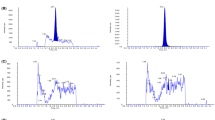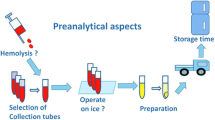Abstract
Volumetric absorptive microsampling (VAMS) is a novel approach that allows single-drop (10 μL) blood collection. Integration of VAMS with mass spectrometry (MS)-based untargeted metabolomics is an attractive solution for both human and animal studies. However, to boost the use of VAMS in metabolomics, key pre-analytical questions need to be addressed. Therefore, in this work, we integrated VAMS in a MS-based untargeted metabolomics workflow and investigated pre-analytical strategies such as sample extraction procedures and metabolome stability at different storage conditions. We first evaluated the best extraction procedure for the polar metabolome and found that the highest number and amount of metabolites were recovered upon extraction with acetonitrile/water (70:30). In contrast, basic conditions (pH 9) resulted in divergent metabolite profiles mainly resulting from the extraction of intracellular metabolites originating from red blood cells. In addition, the prolonged storage of blood samples at room temperature caused significant changes in metabolome composition, but once the VAMS devices were stored at − 80 °C, the metabolome remained stable for up to 6 months. The time used for drying the sample did also affect the metabolome. In fact, some metabolites were rapidly degraded or accumulated in the sample during the first 48 h at room temperature, indicating that a longer drying step will significantly change the concentration in the sample.

Volumetric absorptive microsampling (VAMS) is a novel technology that allows single-drop blood collection and, in combination with mass spectrometry (MS)-based untargeted metabolomics, represents an attractive solution for both human and animal studies. In this work, we integrated VAMS in a MS-based untargeted metabolomics workflow and investigated pre-analytical strategies such as sample extraction procedures and metabolome stability at different storage conditions. The latter revealed that prolonged storage of blood samples at room temperature caused significant changes in metabolome composition, but if VAMS devices were stored at − 80 °C, the metabolome remained stable for up to 6 months






Similar content being viewed by others
References
Guthrie R, Susi A. A simple phenylalanine method for detecting phenylketonuria in large populations of newborn infants. Pediatrics. 1963;32:338–43.
Bennett MJ, Rinaldo P, Wilcken B, Pass KA, Watson MS, Wanders RJ. Newborn screening for metabolic disorders: how are we doing, and where are we going? Clin Chem. 2012;58(2):324–31. doi:10.1373/clinchem.2011.171215.
Corso G, D’Apolito O, Gelzo M, Paglia G, Dello Russo A. A powerful couple in the future of clinical biochemistry: in situ analysis of dried blood spots by ambient mass spectrometry. Bioanalysis. 2010;2(11):1883–91. doi:10.4155/bio.10.149.
D’Apolito O, Garofalo D, Paglia G, Zuppaldi A, Corso G. Orotic acid quantification in dried blood spots and biological fluids by hydrophilic interaction liquid chromatography tandem mass spectrometry. J Sep Sci. 2010;33(6–7):966–73. doi:10.1002/jssc.200900758.
Antunes MV, Charao MF, Linden R. Dried blood spots analysis with mass spectrometry: potentials and pitfalls in therapeutic drug monitoring. Clin Biochem. 2016;49(13–14):1035–46. doi:10.1016/j.clinbiochem.2016.05.004.
Xu Y, Woolf EJ, Agrawal NG, Kothare P, Pucci V, Bateman KP. Merck’s perspective on the implementation of dried blood spot technology in clinical drug development—why, when and how. Bioanalysis. 2013;5(3):341–50. doi:10.4155/bio.12.321.
Stove CP, Ingels AS, De Kesel PM, Lambert WE. Dried blood spots in toxicology: from the cradle to the grave? Crit Rev Toxicol. 2012;42(3):230–43. doi:10.3109/10408444.2011.650790.
Denniff P, Spooner N. Volumetric absorptive microsampling: a dried sample collection technique for quantitative bioanalysis. Anal Chem. 2014;86(16):8489–95. doi:10.1021/ac5022562.
De Kesel PM, Lambert WE, Stove CP. Does volumetric absorptive microsampling eliminate the hematocrit bias for caffeine and paraxanthine in dried blood samples? A comparative study. Anal Chim Acta. 2015;881:65–73. doi:10.1016/j.aca.2015.04.056.
Tannenbaum J, Bennett BT. Russell and Burch’s 3Rs then and now: the need for clarity in definition and purpose. J Am Assoc Lab Anim Sci. 2015;54(2):120–32.
Koulman A, Prentice P, Wong MC, Matthews L, Bond NJ, Eiden M, et al. The development and validation of a fast and robust dried blood spot based lipid profiling method to study infant metabolism. Metabolomics. 2014;10(5):1018–25. doi:10.1007/s11306-014-0628-z.
Denes J, Szabo E, Robinette SL, Szatmari I, Szonyi L, Kreuder JG, et al. Metabonomics of newborn screening dried blood spot samples: a novel approach in the screening and diagnostics of inborn errors of metabolism. Anal Chem. 2012;84(22):10113–20. doi:10.1021/ac302527m.
Wilson I. Global metabolic profiling (metabonomics/metabolomics) using dried blood spots: advantages and pitfalls. Bioanalysis. 2011;3(20):2255–7. doi:10.4155/bio.11.221.
Michopoulos F, Theodoridis G, Smith CJ, Wilson ID. Metabolite profiles from dried blood spots for metabonomic studies using UPLC combined with orthogonal acceleration ToF-MS: effects of different papers and sample storage stability. Bioanalysis. 2011;3(24):2757–67. doi:10.4155/bio.11.280.
Michopoulos F, Theodoridis G, Smith CJ, Wilson ID. Metabolite profiles from dried biofluid spots for metabonomic studies using UPLC combined with oaToF-MS. J Proteome Res. 2010;9(6):3328–34. doi:10.1021/pr100124b.
de Sain-van der Velden MGM, van der Ham M, Gerrits J, Prinsen H, Willemsen M, Pras-Raves ML, et al. Quantification of metabolites in dried blood spots by direct infusion high resolution mass spectrometry. Anal Chim Acta. 2017;979:45–50. doi:10.1016/j.aca.2017.04.038.
Matsubara A, Izumi Y, Nishiumi S, Suzuki M, Azuma T, Fukusaki E, et al. Supercritical fluid extraction as a preparation method for mass spectrometry of dried blood spots. J Chromatogr B Analyt Technol Biomed Life Sci. 2014;969:199–204. doi:10.1016/j.jchromb.2014.08.013.
Dunn WB, Broadhurst D, Begley P, Zelena E, Francis-McIntyre S, Anderson N, et al. Procedures for large-scale metabolic profiling of serum and plasma using gas chromatography and liquid chromatography coupled to mass spectrometry. Nat Protoc. 2011;6(7):1060–83. doi:10.1038/nprot.2011.335.
Paglia G, Hrafnsdottir S, Magnusdottir M, Fleming RM, Thorlacius S, Palsson BO, et al. Monitoring metabolites consumption and secretion in cultured cells using ultra-performance liquid chromatography quadrupole-time of flight mass spectrometry (UPLC-Q-ToF-MS). Anal Bioanal Chem. 2012;402(3):1183–98. doi:10.1007/s00216-011-5556-4.
FDA (2001) Guidance for industry, bioanalytical method validation. Food and Drug Administration, Centre for Drug Valuation and Research (CDER).
Chambers MC, Maclean B, Burke R, Amodei D, Ruderman DL, Neumann S, et al. A cross-platform toolkit for mass spectrometry and proteomics. Nat Biotechnol. 2012;30(10):918–20. doi:10.1038/nbt.2377.
Smith CA, Want EJ, O’Maille G, Abagyan R, Siuzdak G. XCMS: processing mass spectrometry data for metabolite profiling using nonlinear peak alignment, matching, and identification. Anal Chem. 2006;78(3):779–87. doi:10.1021/ac051437y.
Tautenhahn R, Bottcher C, Neumann S. Highly sensitive feature detection for high resolution LC/MS. BMC Bioinformatics. 2008;9:504. doi:10.1186/1471-2105-9-504.
Wehrens R, Hageman JA, van Eeuwijk F, Kooke R, Flood PJ, Wijnker E, et al. Improved batch correction in untargeted MS-based metabolomics. Metabolomics. 2016;12:88. doi:10.1007/s11306-016-1015-8.
Koller M, Stahel WA. Sharpening Wald-type inference in robust regression for small samples. Comput Stat Data Anal. 2011;55(8):2504–15. doi:10.1016/j.csda.2011.02.014.
Xia J, Wishart DS (2016) Using MetaboAnalyst 3.0 for comprehensive metabolomics data analysis. Curr Protoc Bioinformatics 55:14 10 11–14 10 91. doi:10.1002/cpbi.11.
Wishart DS, Jewison T, Guo AC, Wilson M, Knox C, Liu Y, et al. HMDB 3.0—the human metabolome database in 2013. Nucleic Acids Res. 2013;41(Database issue):D801–7. doi:10.1093/nar/gks1065.
Zhu ZJ, Schultz AW, Wang J, Johnson CH, Yannone SM, Patti GJ, et al. Liquid chromatography quadrupole time-of-flight mass spectrometry characterization of metabolites guided by the METLIN database. Nat Protoc. 2013;8(3):451–60. doi:10.1038/nprot.2013.004.
Vuckovic D. Current trends and challenges in sample preparation for global metabolomics using liquid chromatography-mass spectrometry. Anal Bioanal Chem. 2012;403(6):1523–48. doi:10.1007/s00216-012-6039-y.
Hernandes VV, Barbas C, Dudzik D. A review of blood sample handling and pre-processing for metabolomics studies. Electrophoresis. 2017. doi:10.1002/elps.201700086.
Paglia G, Magnusdottir M, Thorlacius S, Sigurjonsson OE, Guethmundsson S, Palsson BO, et al. Intracellular metabolite profiling of platelets: evaluation of extraction processes and chromatographic strategies. J Chromatogr B Analyt Technol Biomed Life Sci. 2012;898:111–20. doi:10.1016/j.jchromb.2012.04.026.
Want EJ, Wilson ID, Gika H, Theodoridis G, Plumb RS, Shockcor J, et al. Global metabolic profiling procedures for urine using UPLC-MS. Nat Protoc. 2010;5(6):1005–18. doi:10.1038/nprot.2010.50.
Zukunft S, Sorgenfrei M, Prehn C, Moller G, Adamski J. Targeted metabolomics of dried blood spot extracts. Chromatographia. 2013;76(19–20):1295–305.
Pattaro C, Gogele M, Mascalzoni D, Melotti R, Schwienbacher C, De Grandi A, et al. The Cooperative Health Research in South Tyrol (CHRIS) study: rationale, objectives, and preliminary results. J Transl Med. 2015;13:348. doi:10.1186/s12967-015-0704-9.
Paglia G, D’Alessandro A, Rolfsson O, Sigurjonsson OE, Bordbar A, Palsson S, et al. Biomarkers defining the metabolic age of red blood cells during cold storage. Blood. 2016;128(13):e43–50. doi:10.1182/blood-2016-06-721688.
Paglia G, Sigurjonsson OE, Bordbar A, Rolfsson O, Magnusdottir M, Palsson S, et al. Metabolic fate of adenine in red blood cells during storage in SAGM solution. Transfusion. 2016;56(10):2538–47. doi:10.1111/trf.13740.
Bordbar A, Johansson PI, Paglia G, Harrison SJ, Wichuk K, Magnusdottir M, et al. Identified metabolic signature for assessing red blood cell unit quality is associated with endothelial damage markers and clinical outcomes. Transfusion. 2016;56(4):852–62. doi:10.1111/trf.13460.
Trinh MU, Blake J, Harrison JR, Gerace R, Ranieri E, Fletcher JM, et al. Quantification of glutamine in dried blood spots and plasma by tandem mass spectrometry for the biochemical diagnosis and monitoring of ornithine transcarbamylase deficiency. Clin Chem. 2003;49(4):681–4.
Hustad S, Eussen S, Midttun O, Ulvik A, van de Kant PM, Morkrid L, et al. Kinetic modeling of storage effects on biomarkers related to B vitamin status and one-carbon metabolism. Clin Chem. 2012;58(2):402–10. doi:10.1373/clinchem.2011.174490.
Li W, Zhang J, Tse FL. Strategies in quantitative LC-MS/MS analysis of unstable small molecules in biological matrices. Biomed Chromatogr. 2011;25(1–2):258–77. doi:10.1002/bmc.1572.
Chen J, Hsieh Y. Stabilizing drug molecules in biological samples. Ther Drug Monit. 2005;27(5):617–24.
Liu G, Ji QC, Jemal M, Tymiak AA, Arnold ME. Approach to evaluating dried blood spot sample stability during drying process and discovery of a treated card to maintain analyte stability by rapid on-card pH modification. Anal Chem. 2011;83(23):9033–8. doi:10.1021/ac2023876.
Denniff P, Parry S, Dopson W, Spooner N. Quantitative bioanalysis of paracetamol in rats using volumetric absorptive microsampling (VAMS). J Pharm Biomed Anal. 2015;108:61–9. doi:10.1016/j.jpba.2015.01.052.
Acknowledgements
This work was supported by the FWF-funded doctoral program HOROS and by a transnational PhD research project between the Medical University of Innsbruck and the EURAC research in Bolzano (BI-DOC project).
Author information
Authors and Affiliations
Corresponding author
Ethics declarations
This study was performed in accordance with the ethical standards. The local ethics committee (Comitato etico del comprensorio sanitario di Bolzano) approved the study, and all participants provided written informed consent.
Conflict of interest
The authors declare that they have no competing interests.
Electronic supplementary material
ESM 1
(PDF 545 kb)
Rights and permissions
About this article
Cite this article
Volani, C., Caprioli, G., Calderisi, G. et al. Pre-analytic evaluation of volumetric absorptive microsampling and integration in a mass spectrometry-based metabolomics workflow. Anal Bioanal Chem 409, 6263–6276 (2017). https://doi.org/10.1007/s00216-017-0571-8
Received:
Revised:
Accepted:
Published:
Issue Date:
DOI: https://doi.org/10.1007/s00216-017-0571-8




